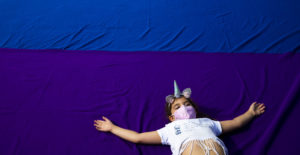Exactly how old is Barbie, anyway? I speak not of Barbie the product — though her birth in 1959 is a fascinating story — but Barbie the person, the character, the entity who exists in undying hot pink perpetuity, in another dimension, “Barbie World”.
Whatever age she’s permanently frozen at, she’s quite the achiever. A by-no-means complete list of her professions includes doctor, lifeguard, news anchor. She’s been both ballerina and ballet teacher. She’s served in every branch of the US military and as a cashier at various fast-food franchises. She’s even run for president — four times.
So, she’s young enough to work the menial jobs we associate with teenagers, but old enough to hold the country’s highest office (for which eligibility begins at 35). Barbie’s age is like her identity, then: infinitely malleable, and entirely dependent on how she’s accessorised. Nor is she constrained by class or education. When it comes to the milestones of adult life, she achieves some of them with ease (a Dream House), while lingering permanently on the threshold of others (marriage, children).
The only thing that doesn’t change is her silhouette. The classic Barbie always looks exactly the same: wasp waist, lifted heels, improbably huge plastic breasts.
But what’s most interesting about Barbie is how, in being unconstrained — not just by age, class, or education, but by adult trappings like marriage and children — she embodies the paradoxes of an entire generation of women. Like Barbie, the Archetypal Millennial is both wildly accomplished yet developmentally trapped in perpetual adolescence: she dates less, marries later, and has fewer children, if she has them at all. Like Barbie, she lives in a world where women eclipse men on so many fronts that the latter become an afterthought, their comparative underachievement something between a punchline and a national crisis. And like Barbie, she is expected to be not just hot, but hot in perpetuity, in a way that previous generations were not — if only because the means to achieve it were not yet widely accessible.
Millennial women’s entry into middle age has run in parallel to a veritable revolution in the business of appearance management — one characterised by low-cost Botox, ten-step skincare regimens, and those Instagram photo filters that make you look not just ageless but eerily smooth, something between a Pixar cartoon and a baby. Two things are true: that the past decade has given birth to a highly visible movement advocating body positivity and acceptance, and also, that the aspirations of women throughout Western society suggest that none of them actually believe in it. With enough time, effort and money, it is now possible for a committed woman to be hot virtually indefinitely; it is also increasingly understood that ambitious women probably should make this commitment, investing in their own faces for the same reasons that they pay into a pension.
The result is paradoxical: no matter how much you achieve, the greatest mark of success for women is to look too young to have achieved much of anything.
Enter Margot Robbie, the actress who plays the eponymous doll on the big screen, and who has lately been bearing the full weight of the Barbie discourse on her perfectly sculpted shoulders. While mainstream media outlets derided Robbie for failing to wear more “intelligent” outfits while promoting the film — that is, for being too hot — she was also hilariously negged online for being “mid” — that is, middling, on the one-to-ten scale of hotness. The negging came, of course, from a bunch of internet Kens: men who, figuratively speaking, clearly have naught but a modest plastic bulge where their manhood should be.
That Robbie somehow exists simultaneously in the oppositional states of being both not hot enough and also too hot to be taken seriously is intriguing. But then, at 33, Robbie is squarely in the age bracket of women who (according to some people, anyway), are at imminent risk of “hitting the wall”, a term that describes the abrupt (and, it must be said, entirely mythological) deflation of a woman’s sex appeal the moment she ages past 25. It’s not hard to see where this comes from: in a world where women are out-achieving men, a man may retaliate by trying to instil in a woman the sense that her true value to society is in her youthful good looks and fertility. She must settle down now, urgently, with any man who’ll have her — specifically, with him — before that asset value falls off a cliff.
Do these men want a living, breathing Barbie doll? They do appear to be the market for the NPC streamer, a new genre of professional hot girl. These face-tuned young woman perform on TikTok livestream, keeping up a constant stream of repetitive chatter while fans pay anywhere from a few cents to a dollar to send her virtual tokens. For those with a big following and the stamina to perform for hours on end, a single streaming session can net them thousands of dollars. The fact that the average NPC streamer’s fanbase is largely male has given rise to the theory that their performances satisfy a not necessarily sexual fetish for control — that, much like the tradbro posting about how the sight of 27-year-old Sophie Turner makes him want to vomit, the whole thing is an attempt by flailing men to reassert dominance, if only in one narrow way, over women.
On the other hand, who actually has the power in these scenarios? The woman making bank off a pretend performance of vacant, poseable femininity, or the guy glued to the screen? A video of one of these women breaking character to discipline a child somewhere out of frame reveals just how calculated these personas are. It’s like seeing a Disney princess briefly pausing mid-song to belch and drag on a cigarette. In a way, the NPC streamers have cracked the code: they’re hot, but in a cartoonish way that was never meant to be taken seriously — which is to say, in the way that Barbie was once understood to be, before we got it into our heads that she needed to be something more. Something like a role model.
Barbie is the original problematic fave. The Barbie movie, then, is more than a nostalgia product; it is a redemption, or at least a chance at one. Under the direction of Greta Gerwig — whose polarising adaption of Little Women repackaged a story millennial women had come to hate ourselves for loving — we are offered, if not empowerment, then at least forgiveness, for our toxic relationship with all things Barbie. “The story of Barbie is the fight that has been going on about Barbie,” Gerwig told the New York Times last week. “I’m doing the thing and subverting the thing.” The thing, of course, is Barbie-brand femininity, and its well-documented conflict with feminist mores, enumerated in the movie by a teenager who breaks the heart of Robbie’s Barbie by explaining to her exactly how bad she’s been for women.
“Doing the thing and subverting the thing” is not a bad description of millennial womanhood circa 2023. For the generation that invented “adulting” enters the age of the midlife crisis, Barbie is an avatar for all the problems we don’t know how to solve. How does a smart woman succeed in an attention economy that dictates who and what is worthy of being seen, and who will fade into obscurity? What does a girl have to do these days for her face to be, if not acceptable, at least not a topic of conversation? Is performing femininity subversively that different from just performing femininity?
If Gerwig pulls it off, Barbie could be the cinematic version of the privilege acknowledgment so ubiquitous in the work of millennial women writers: a sort of ritual confession of fallibility that then frees you to do whatever you want. It might even do for its millennial audience what Fight Club did for the men of Generation X, or American Beauty for Baby Boomers. These movies, released amid what Fukuyama once called “the boredom at the end of history” — 9/11 was years off yet, and the internet still in its infancy — captured the distressing condition of having finally grown up only to hit the wall, not of your waning sexual desirability, but of your own inherent purposelessness. Consider Fight Club’s famous monologue, an ode to the listless angst of the middle-class American male:
“Goddammit, an entire generation pumping gas, waiting tables, slaves with white collars. Advertising has us chasing cars and clothes, working jobs we hate so we can buy shit we don’t need. We’re the middle children of history, man; no purpose or place. We have no Great War, no Great Depression. Our Great War is a spiritual war. Our Great Depression is our lives.”
Nearly 20 years later, perhaps it is millennial women’s turn to look around — at what we were promised, what we were told to want — and ask: is that all there is?
Gerwig’s Barbie is, in reckoning with the idea that she’s failed other women, having an existential crisis — one that mirrors the reinvention of Mattel’s Barbie for a more feminist world. Her professions may have been diverse, but in 2015, the company revamped its line of Barbie dolls to include more skin colours, hair textures, and — for the first time — body sizes. The image overhaul was an adapt-or-die plea to find new footing in a changing culture, one that seems to have worked. How is it, then, that just as the beauty and body standards of Barbie World finally expanded to become more diverse, real-world women are flooding plastic surgeons’ offices with requests for the same generic Instagram face?
The irony is that while Barbie prepares to launch her fifth presidential run, while also coding and dancing and saving the whales, millennial women are still trying to figure out how to have it all. Is it possible to dodge the social obligation of remaining Fuckable Literally Forever, yet also remain seen, in a world where women of a certain age have a way of becoming invisible? It remains to be seen if Gerwig can answer millennial woman’s questions, but she seems to offer hope. If Barbie can remake herself against the gravitational pull of obsolescence, if she can rage, rage against the dying of her cultural relevance, then maybe, so can we.
Disclaimer
Some of the posts we share are controversial and we do not necessarily agree with them in the whole extend. Sometimes we agree with the content or part of it but we do not agree with the narration or language. Nevertheless we find them somehow interesting, valuable and/or informative or we share them, because we strongly believe in freedom of speech, free press and journalism. We strongly encourage you to have a critical approach to all the content, do your own research and analysis to build your own opinion.
We would be glad to have your feedback.
Source: UnHerd Read the original article here: https://unherd.com/




